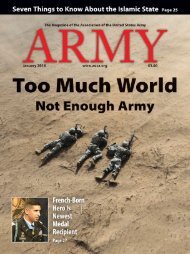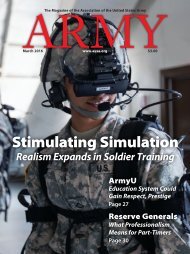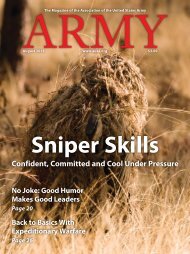Army - Kicking Tires On Jltv
You also want an ePaper? Increase the reach of your titles
YUMPU automatically turns print PDFs into web optimized ePapers that Google loves.
FREE TO<br />
AUSA<br />
MEMBERS<br />
Receive AUSA’s<br />
Legislative Newsletter<br />
electronically each<br />
week.<br />
Stay current on<br />
legislative activity that<br />
affects you.<br />
E-mail AUSA at<br />
jrudowski@ausa.org<br />
using the subject line<br />
“Newsletter” to begin<br />
your free subscription.<br />
terrain for effective fields of fire. Understanding<br />
this, the reader should regard<br />
the 3rd Division’s stand on the Marne<br />
River on July 15, 1918, differently, at<br />
least in terms of the criticisms leveled at<br />
French units on the division’s flanks.<br />
Lengel ably shows how U.S. commanders<br />
exaggerated the importance of almost<br />
every battle, claiming their units<br />
fought at the point of main enemy effort,<br />
against overwhelming odds and elite<br />
German units, and without the considerable<br />
support of their Allies, among other<br />
factors. Again, the Champagne-Marne<br />
defensive serves as a great example.<br />
For 100 years, the 3rd Marne Division<br />
proudly claimed to have saved Paris. It<br />
didn’t. Lengel clearly documents that the<br />
German attack on the Marne was a supporting<br />
effort in a secondary area with no<br />
intention of reaching Paris. This does not<br />
denigrate the valor and sacrifice of the<br />
brave men positioned along the Marne in<br />
the middle of July, but it does place the<br />
battle’s importance in proper perspective.<br />
Lengel lays the responsibility for thousands<br />
of needless deaths at the feet of inexperienced<br />
and incompetent commanders<br />
at all levels who failed to prevent<br />
junior leaders and soldiers from using<br />
outdated and fatal linear tactics in the<br />
face of machine guns and massed artillery.<br />
He discusses the age-old problem of<br />
where on the battlefield commanders<br />
should be to decisively affect the fight—<br />
he takes the chain of command of the<br />
2nd Division to task for this failure in<br />
the battle for Belleau Wood, where commanders<br />
made the wrong decision with<br />
incomplete information while far removed<br />
from the fight.<br />
He also excoriates the 2nd Brigade,<br />
1st Division’s commander, Brig. Gen.<br />
Beaumont Buck, for “whizzing about the<br />
battlefields, with no obvious purpose<br />
other than to see what a real war looked<br />
like” while his brigade was being decimated<br />
in the attack south of Soissons,<br />
July 18–22, 1918.<br />
Lengel takes commanders at all levels<br />
to task for not passing on their units’<br />
lessons learned from early combat actions,<br />
with new units repeating the mistakes<br />
made by the “experienced” divisions<br />
because they did not know better.<br />
Brig. Gen. James Harbord, commanding<br />
the 4th Brigade, 2nd Division, appears<br />
to be criminally negligent in his failure to<br />
pass on lessons learned by the Marines in<br />
Belleau Wood to the 7th Infantry Regiment<br />
that replaced them, condemning<br />
that unit to failure and resulting in hundreds<br />
of needless deaths.<br />
This book contains many more critical<br />
observations and new interpretations<br />
that will challenge readers’ understanding<br />
of the American Expeditionary<br />
Forces’ performance in World War I.<br />
Each point is well-argued and well-supported.<br />
Commanders and units are exposed<br />
to criticism, with some looking<br />
better and some looking worse once seen<br />
through Lengel’s lens.<br />
Despite the many critical assessments<br />
made in this book, the American soldiers<br />
and Marines who fought in difficult conditions<br />
under often-incompetent commanders<br />
and with terrible logistic support<br />
are judged to be brave men who<br />
performed their duty as best they knew<br />
how, and with an aggressive spirit and<br />
abiding faith in the superiority of the<br />
American way.<br />
The French poilu and French colonial<br />
troops are given the due they have<br />
been denied by American historians for<br />
nearly a century. The German landser is<br />
shown to be no Superman, but is still<br />
depicted as a brave and determined foe<br />
who continued to fight with discipline<br />
and cunning even as the cause appeared<br />
to be lost.<br />
I heartily recommend Lengel’s excellent<br />
book to anyone interested in the<br />
American Expeditionary Forces in World<br />
War I, and the development of the U.S.<br />
<strong>Army</strong> into a professional fighting force.<br />
Lt. Col. Timothy R. Stoy, USA Ret., is the<br />
historian for the 15th Infantry Regiment<br />
Association and the Society of the 3rd Infantry<br />
Division.<br />
1-855-246-6269<br />
That’s the toll-free number to call<br />
AUSA national headquarters. The AUSA<br />
Action Line is open 8 a.m.–5 p.m. Monday<br />
through Thursday, and 8 a.m.–1:30<br />
p.m. Friday, except holidays. If you have<br />
a question about AUSA, give us a call.<br />
70 ARMY ■ February 2016

















